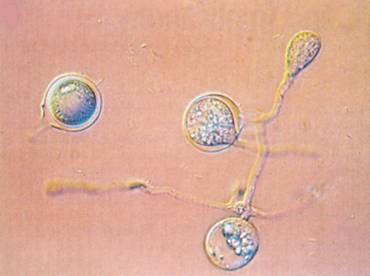

|
Adaptation |
|
P. infestans has caused more of a problem in recent years than one would have expected. In the mid 1980’s, over a hundred years after causing the potato famine in Ireland, a second mating type was discovered in North America. |
|
You Can’t kill What Keeps Changing |



|
This, of course, allows the organism to sexually reproduce, which in turn allows for quicker exchanging of genes and quicker development for resistance to some of the most widely used pesticides (Volk 2001). These mating types, A1 and A2, can both produce antheridia, oogonia, or both types of gametangia. If the antheridia and oogonia originate from different parents, they can either fuse together to form hybrid oospores or mate with itself—see the life cycle of P. infestans for visualization (Judelson 1997). |
|
Photo Credits 1. Courtesy W. E. Fry. Reproduced with permission from Schumann, G. L. and C. J. D’Arcy. 2000. Late blight of potato and tomato. The Plant Health Instructor. DOI: 10.1094/PHI-I-2000-0724-01. 2. Courtesy D. Inglis. Reproduced with permission from Schumann, G. L. and C. J. D’Arcy. 2000. Late blight of potato and tomato. The Plant Health Instructor. DOI: 10.1094/PHI-I-2000-0724-01. |
|
Oospore germinating via production of a sporangium (1). |
|
Transmission of Phytophthora infestans from an infected seed tuber to the sprout (2). |